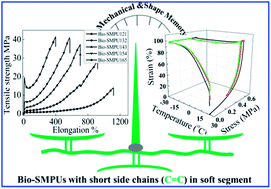Bio-based shape memory polyurethanes (Bio-SMPUs) with short side chains in the soft segment†
Abstract
One of the obvious shortcomings of bio-based shape memory polyurethanes (Bio-SMPUs), which usually use natural oil based polyols as the soft segment, is their low mechanical strength because the long dangling chains (six to eight carbons) in these polyols prevent the Bio-SMPUs from deep micro-phase separation, and consequently deteriorate their mechanical properties. In this work, we prepared a bio-based polyester diol for the soft segment, in which short side chains (C![[double bond, length as m-dash]](https://www.rsc.org/images/entities/char_e001.gif) C) were used to tune the transition temperature and the morphology of the Bio-SMPUs. The moderate concentration of short branch chains barely affects the micro-phase separation, and the mechanical properties of the Bio-SMPUs are quite satisfactory. With the same 70 wt% soft segment content, the tensile strength in this work is 13.2 MPa, while the one using ricinoleate-based soft segments reported 2.8 MPa. Through proper shape memory programming, the synthesized Bio-SMPUs show good shape memory properties with a shape fixing rate of greater than 98% and a shape recovery rate of 85% in the first cycle and greater than 90% in the following cycles. This study provides a framework for developing bio-based SMPUs with high mechanical and good shape memory properties at the same time.
C) were used to tune the transition temperature and the morphology of the Bio-SMPUs. The moderate concentration of short branch chains barely affects the micro-phase separation, and the mechanical properties of the Bio-SMPUs are quite satisfactory. With the same 70 wt% soft segment content, the tensile strength in this work is 13.2 MPa, while the one using ricinoleate-based soft segments reported 2.8 MPa. Through proper shape memory programming, the synthesized Bio-SMPUs show good shape memory properties with a shape fixing rate of greater than 98% and a shape recovery rate of 85% in the first cycle and greater than 90% in the following cycles. This study provides a framework for developing bio-based SMPUs with high mechanical and good shape memory properties at the same time.


 Please wait while we load your content...
Please wait while we load your content...